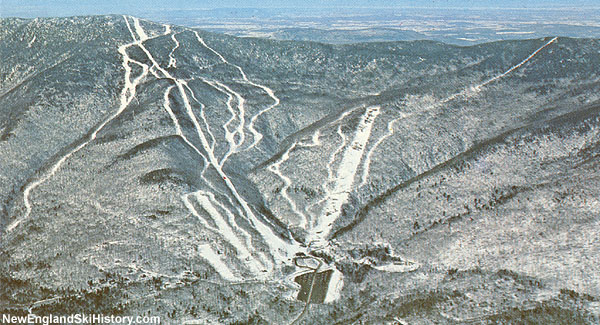
|
| Glen Ellen |
| Warren, Vermont |
| Status: |
Merged
|
| First Season: | 1963-64 |
| Last Season: | |
| Vertical Drop: | 2600 feet |
| Standing Lifts: | |
| Past Lifts: | |
| Left: Glen Ellen circa the late 1960s or early 1970s |
| Recent NewEnglandSkiIndustry.com News:
|
|
Located on the highpoint of Lincoln Mountain, between Sugarbush's Lincoln Peak and Mad River Glen, Sugarbush North was originally developed as a standalone area known as Glen Ellen.
Walt Elliott Develops a Ski Area
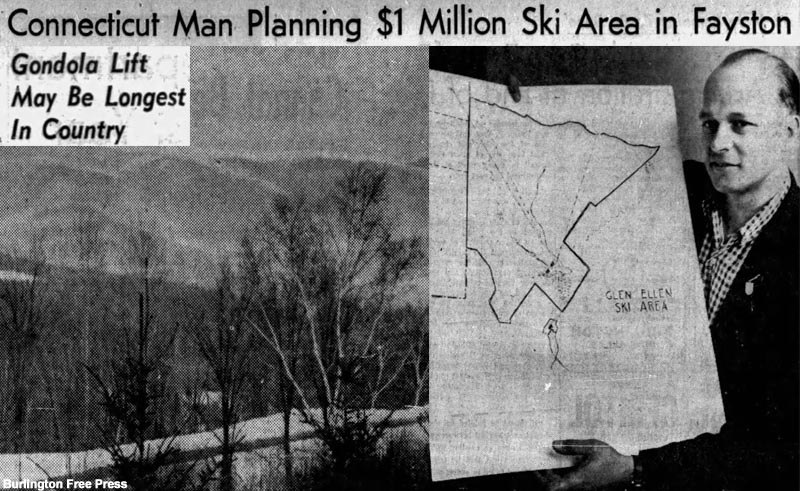
Walt Elliott showing early Glen Ellen plans |
Born in Port Arthur, Texas in 1928, Walton Sellers Elliott attended school in Yonkers, New York and Greenwich, Connecticut. Elliott also reportedly spent time in London and South Africa. After obtaining an engineering degree from Cornell University, Elliott served as a thermal engineering specialist in the military at the Ordnance Guided Missile Center. Elliott subsequently worked at Armstrong Cork Company and Gustin-Bacon Manufacturing Company. As the story goes, Walt Elliott told his wife Cynthia that he wanted to relocate from Connecticut to Vermont to start a ski area.
Elliott established Glen Ellen Corporation January 25, 1962, naming the project after the shelter near the Long Trail. Options were procured on 1,650 acres of land on the eastern face of 4,083 foot Mt. Ellen.
In February, Elliott announced his plans for Glen Ellen, aiming for a 1962-63 debut. In addition to the privately held land, Elliott hoped to obtain a use permit from the United States Forest Service on high-elevation terrain to give the area a 2,675 foot vertical drop, which would be the largest in New England. Elliott planned to install the longest gondola in the country at 10,000 feet, plus a double chairlift, a T-Bar, and a J-Bar, serving 8 trails of all abilities. The estimated price tag was $920,000. Elliott noted that, "I've been looking at this area, studying its topography. I've skied it and hiked it and I'm convinced, geographically this is what we want. It's in the maximum snow belt area of the state and two ridges form a natural bowl considered ideal for retention of snow. Besides that, the entire area has recently been logged and is virtually free of any exposed rock ledges which will facilitate trail design and construction."
In March, Fayston voters approved a 5-year tax exemption for Glen Ellen.
In April, Glen Ellen acquired 250 acres of land from Ward Lumber Company for $10,000.
In October, Elliott announced that 1,589 acres of land had been purchased and that remaining funds would be focused on construction. A 6,000 foot double chair lift line had been cleared and work on an access road was soon to follow. Meanwhile, plans for the gondola had been abandoned in favor of tiered double chairlifts. With a 1962-63 debut no longer attainable, sights were set on the 1963-64 season.
As the project heated up, its lawyer, recently-elected Governor Philip Hoff, resigned his post with the company to avoid any conflict-of-interest concerns, retaining a small ownership stake. Meanwhile, legislation was moving forward to rebuild German Flats Road and build a new access road to Glen Ellen.
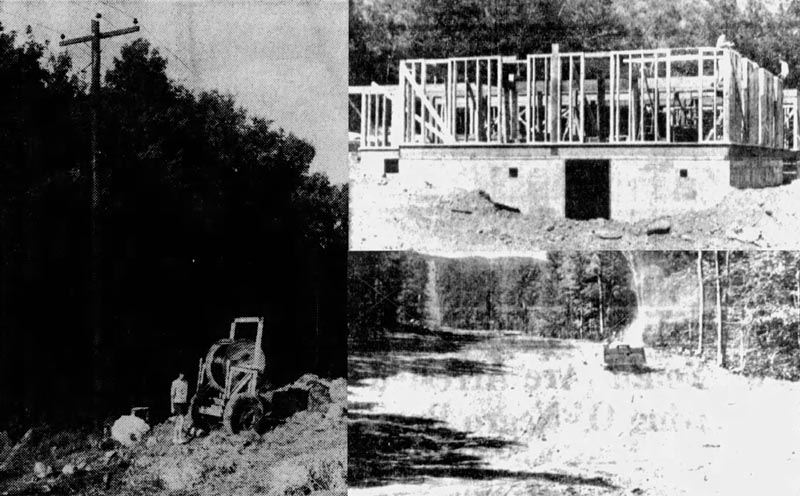
Construction of Glen Ellen (1963) |
With construction paused during the winter of 1962-63, Elliott offered free snowcat-served skiing, telling the Burlington Free Press, "We want as many people as possible to take a look at what we have and what we will have." By this point, Elliott had split construction into three phases - a 1963-64 debut with a 1,565 vertical foot double chairlift and a T-Bar, a double chairlift to the summit and a novice chairlift for the 1964-65 season, and tiered chairlifts to near the summit of General Stark Mountain for the third phase. The base lodge was designed by Lench and Associates to take a barn-like roof design to reflect a Vermont feel, rather than a "transplanted European resort."
In September 1963, word emerged that longtime Bromley ski school director Neil Robinson had resigned his post so that he could start a ski school at Glen Ellen. Initially set to be in the 10th Mountain Division, Robinson broke his ankle filming a ski movie and was subsequently assigned as a surgical technician in the Philippines during World War II. In addition to teaching at Pico and Bromley, Robinson was known for his appearances in John Jay and Warren Miller ski movies.
As calendar fall arrived, trails had been cut and excavated, lift footings had been poured, and the first floor of the Golden Thistle base lodge was being framed. Two double chairlifts and a T-Bar were constructed for the debut season, serving 10 trails and 2 slopes following a Scottish naming theme. The cost of the initial development was reported as $550,000.
Glen Ellen Debuts
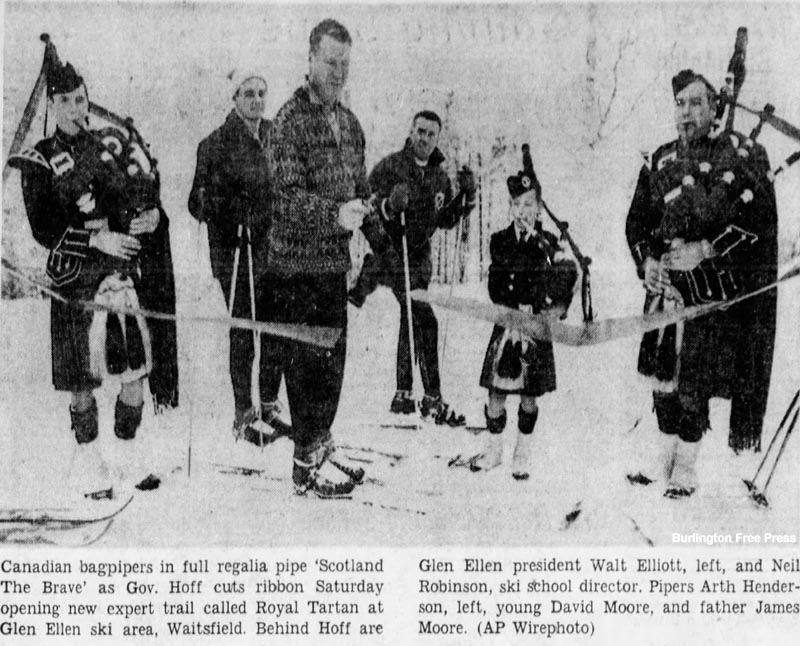
A typical Glen Ellen dedication |
A December 14 opening ceremony was advertised with Governor Hoff officiating. To mark the occasion, Glen Ellen offered free skiing and lunch to all Vermont residents. Natural snow arrived two days prior to the scheduled debut, enabling skiing. The area was still very much a work in progress, with Burlington Free Press writer Dave Schaefer noting that the restrooms did not have water or doors until mid-afternoon, "just as the look of panic was beginning to show in the faces of those who had been standing on one foot, then the other." Only the novice chairlift was operational at that point, and the lodge was described as "an attractive unit that undoubtably will prove too small until phase two of the Glen Ellen development expands it."
With the main mountain chairlift finally in operation, Glen Ellen began hosting weekly races in late January. The Glen Ellen Ski Club was formed later that winter to further the development of racing at the area.
Meager snowfall caught the young owner by surprise, as he commented to the New York Times, "We realized that customers wouldn't immediately start breaking down the doors to ride our lifts, but we didn't anticipate lean snow covers, either. The mountains in these parts are supposed to work like magic in attracting flakes." Nevertheless, snow finally arrived, boosting reported base depths to nearly three to four feet by the end of February, and allowing for the season to extend to the second weekend in April. Citing the subpar snowfall, Glen Ellen posted a net loss of $84,700 for its first season.
To The Summit
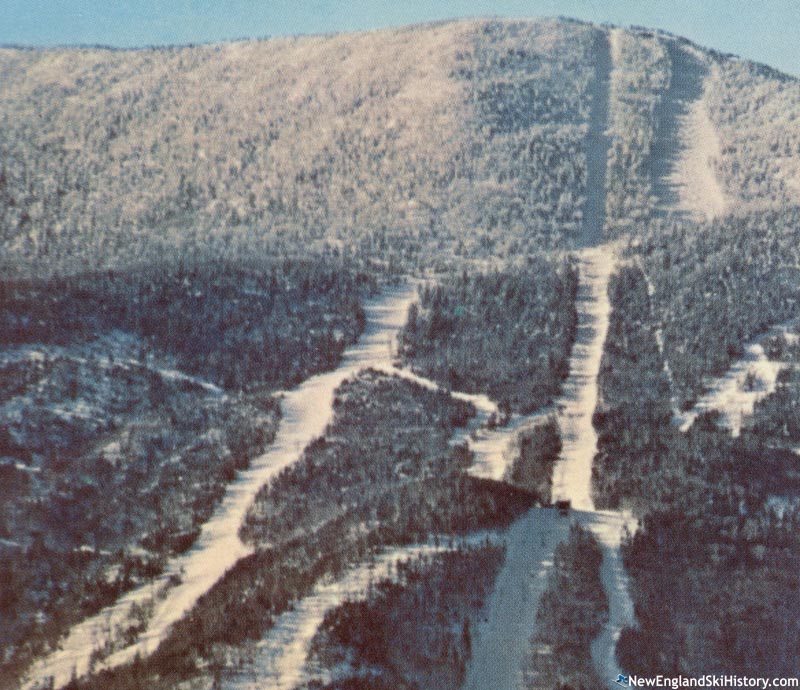
Upper Glen Ellen |
Glen Ellen finally received the green light to expand to the summit in late July 1964, picking up a 59-acre permit from the United States Forest Service. Plans were quickly announced to take delivery of a new chairlift for the end of the summer and to construct the Glen House near its base. Six new trails were added, boosting the trail count to 19.
Other changes included a sun duck on the base lodge and pavement on the access road. With neighbor Sugarbush advertising "greatest vertical rise in east" courtesy its top to bottom gondola, Glen Ellen carried the "greatest vertical descent in east" slogan with its tiered chairlifts and 2,645 foot vertical drop. Phase III expansion plans were also publicized around this time, to begin in 1965. Two chairlifts approaching General Stark Mountain were announced, serving 8 trails. In concert with the expansion, a 50-acre village of chalets, lodges and inns, restaurants, and shops was planned near the base lodge.
The area picked up eight inches of snow at elevation on Columbus Day weekend, resulting in impromptu snow cat rides for about a dozen skiers. The 1964-65 season launched on a rainy December 12th with free skiing in honor of the new summit chairlift. Flanked by bagpipers, Governor Philip Hoff dedicated the new lift by telling Elliott, "You made this dream come true and I want to congratulate you."
Glen Ellen and other areas in the region struggled with poor snowfall until a storm of substance finally hit later in January. Revenue surpassed the first season's total on February 25, but was still significantly less than expected. Though the season extended into at least mid-April, the area posted a net loss of $88,600 for its sophomore season.
Around this time, plans were publicized for constructing the Inn at Glen Ellen. A $250,000 building was announced, designed by Marcel Beaudin, with 30 rooms to be ready by December 1965. In addition, three new trails and a base lodge expansion were announced. Details about the expansion emerged as the fall arrived, with the new trail count increasing to five, including Lower FIS, High Road, and Royal Tartan. Lift lines toward General Stark Mountain were also reportedly cut, with new chairlifts proposed for 1966. The upper portion of the proposed area would "put Glen Ellen ski terrain back to back with Mad River Glen's Catamount Bowl," according to the Burlington Free Press. Bruno Hennessey, a European lift engineer, was hired to design and supervise the terrain and lift expansion. New wings were added to the base lodge, reportedly doubling dining space and adding a nursery. A dedication ceremony with Governor Hoff was announced for December 18.
The 1965-66 season reportedly started on the weekend before Thanksgiving, thanks to a foot to a foot and a half of early season snow. A photo of a hunter dragging a deer across a slope on opening day made regional newspapers. Governor Hoff dedicated the Royal Tartan trail and $60,000 base lodge addition on December 18, once again flanked by bagpipers. By this point, reported base depths were approaching two to three feet. The area enjoyed a strong start to the Christmas week before warm weather ushered in the New Year. Despite the thaw, revenue was reportedly 110% ahead of the prior season.
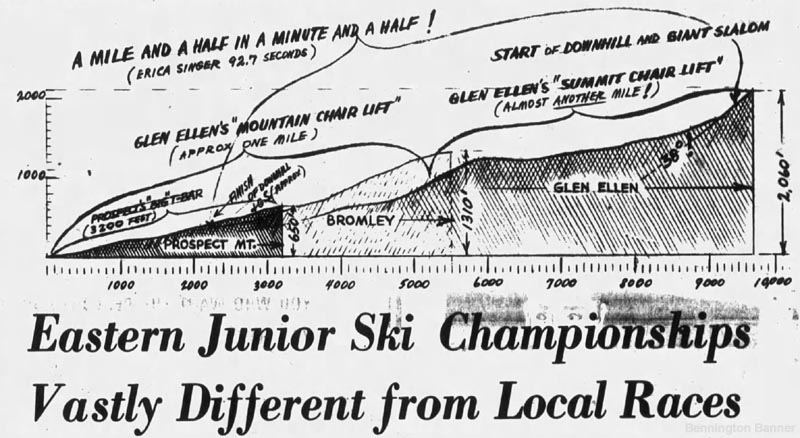
A 1966 race diagram |
The first race on the new Lower FIS trail was held in late January, when Dave Irish of St. Michael's College won the Glen Ellen Senior Downhill. The Eastern Amateur Junior Alpine Championship was held one month later, with Duncan Cullman winning the overall race and Marilyn, Barbara, and Bobby Cochran earning slots on the Eastern Junior Alpine team.
Reported base depths peaked at over two to six feet at the end of calendar winter. While neighbor Sugarbush closed in mid-April due to a lack of skiers, Glen Ellen announced plans to continue until May 1, making it possibly only the third area in state history to reach the month.
Meanwhile, Fayston voters refused to extend a tax abatement for the planned lodging facility. Despite the setback, Elliott announced the 42-unit Inn at Glen Ellen would be moving forward in April 1966. Designed by Marcel Beaudin, the $500,0000 inn was to include amenities such a lounge, a ski locker room, a salon, a recreation room, a pool, a tennis court, and a stable. Air conditioning was also included in the design to anticipate hot summer days. Future plans included 24 additional units.
A brush fire broke out while crews were clearing new trails on the mountain in late October 1966, resulting in 30 acres of burned grass and leaves.
A ski patrol building was lifted onto the top of the ski area via helicopter in late November, leading Walt Elliott to pronounce it "the highest building in Vermont."
The 1966-67 season kicked off in early December. A lack of snow hampered skiing leading into Christmas weekend, but two subsequent snowstorms boosted business in advance of New Year's weekend.
Glen Ellen hosted the Eastern Senior Alpine Championship in March. Karen Middleton won the women's title, while future Woodbury owner Rod Taylor won the men's title. Spring came quickly, likely ending the season at the start of April.
As one of a select few ski areas in the Northeast that had adequate vertical, Glen Ellen was considered as a potential venue for a 1976 Olympic bid. Though Waterbury put its hat in the ring, the town subsequently withdrew its bid due to a lack of funds. Walt Elliott turned his attention to seeking to host the FIS championships.
Construction on the long-awaited Inn at Glen Ellen started in June 1967. Now carrying a price tag of $600,000, the facility was slated to open in December. Off-season work on the ski area was focused on removing rocks and stumps from FIS and the new trails in the future Inverness area By this point, the novice T-Bar had been reportedly converted to a Pomalift. Test borings were also reportedly drilled to locate a water supply for a future snowmaking installation due to the "whimsicality of Vermont weather," according to the Rutland Daily Herald.
Nearly two feet of snow fell a few days before Thanksgiving, allowing for Glen Ellen's second November opening in five seasons. Subsequent rain dampened lower mountain skiing, but high elevation trails were described by the resort as "unbelievable." As Christmas week arrived, upper mountain conditions continued to be reported as strong, while the lower mountain dealt with bare spots. Subsequent snow reportedly boosted New Year's business.
Glen Ellen hosted its first annual Eastern Continental Gelandesprung in January 1968, attracting amateur and professional skiers to the jumping competition. The event was won by Rod Taylor.
A warm, wet start to spring likely brought the season to a close after the first weekend of April with skiing on the upper mountain only.
After five seasons of varying lengths, Glen Ellen installed snowmaking in 1968. A 2.5 million gallon pond was constructed near the base lodge, with pipelines installed in the novice chairlift area. Twenty-nine snow guns were purchased for the initial installation. A new upper mountain trail was also reportedly cut that off-season. New chairs were installed on the novice chairlift, while the existing novice chairlift chairs were moved to the Mountain and Summit lifts to boost uphill capacity by 30%. Styrofoam seat pads were added to those chairlifts to make the rides less cold. Former French ski team member Pierre Stamos was named ski school director, while Tommy Baird took over as operations manager. Diversifying its reach, Glen Ellen joined Pico, Magic, and Haystack to offer a joint season pass. Meanwhile, construction on the Inn at Glen Ellen had ceased due to a lack of funding and general contractor Hall Associates filed suit over delinquent payments.
A large, early season snow storm allowed Glen Ellen to open in mid-November 1968. Though early skiing was welcome, the storm delayed the installation of snowmaking. Lower mountain skiing was initially limited, but by mid-January, Glen Ellen was reporting base depths of 4 to 8 feet. A month later, the snow reports exceeded 5 to 9 feet, but the financial situation remained concerning. The Rutland Herald reported rumors that the ski area was for sale due to an accumulated $250,000 in debt, and that Elliott was seeking a $1 million capital infusion.
The deep base depths persisted well into the spring of 1969, allowing Glen Ellen to operate the Summit Chair into the first weekend of May.
Lightning struck the top terminal of the Summit Chair in mid-July 1969. Due to the rugged terrain, staff was unable to get to the scene in time to save the top terminal and lift shack. Meanwhile, construction of the Inn at Glen Ellen resumed after two years, with a roof being installed before financing once again ran out.
Changes for the 1969-70 season included a rebuilt top terminal for the summit chair, possibly completing the novice area snowmaking system, and cutting a new novice trail. The season kicked off on one manmade trail after Thanksgiving. Skiing was limited in December due to a lack of natural snow and the on-going rebuild of the Summit Chair. To mark the reopening of the lift, Glen Ellen offered free skiing on Christmas Day.
In January 1970, Glen Ellen joined Killington and Sugarbush to lobby the state to convert Roxbury Mountain Road into a paved highway. The areas argued that visitation from Southern New England was hampered due to the roads, and that the proposed highway would provide easy access from Interstate 89.
In February, Glen Ellen came under criticism in the regional press when it started charging racers for lift tickets. The situation came to a head when the North Country Union High School did not have money to purchase tickets and was forced to hike up the mountain to participate in a race. The Bennington Banner called the policy "short-sighted to say the least," while the Rutland Herald accused the area of "trying to have their cake and eat it too." Glen Ellen told the Burlington Free Press that the policy emerged after "seven years of abuse," noting, "We're in business too; we have a mountain to run."
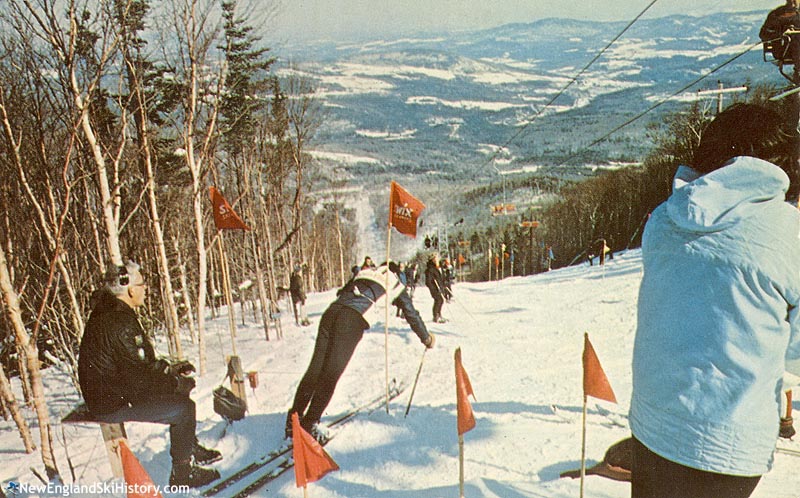
Racing at Glen Ellen |
Glen Ellen and Mad River Glen co-hosted the National Alpine Championships in mid-March 1970, with Glen Ellen slated to host the downhill and slalom events. During a downhill training run on what was described as an icy and bumpy FIS, US ski team member Debbie Flanders fell at a speed reportedly exceeding 65 miles per hour. The resulting shattered tibia and fibula eventually ended her racing career. Amidst fog and falling snow, the men's downhill was won by Rod Taylor, with Bob Cochran coming in second, while the women's downhill was won by Ann Black with Rosie Fortna coming in second. Rod Taylor noted, "It was so bad, you could barely see a gate ahead of you." The slalom events were won by Bob Cochran and Patty Boydstun.
The 1969-70 season extended into at least late April, with one Connecticut publication later claiming a May 5 closing.
Attempted Sale
Meanwhile in March 1970, word emerged about a potential ownership change. Walt Elliott announced that Glen Ellen's board of directors accepted a merger offer from Suburban Propane Gas Corp. of New Jersey. As part of the $2 million deal, Glen Ellen would become a subsidiary of Suburban Propane Gas Corp., while the company would also buy 150 acres from Elliott and two-thirds of the Inn at Glen Ellen, which was still under construction. Sno-Engineering was hired by the company to conduct a feasibility study. Elliott told locals that he was 99% sure the deal would be executed.
In June, Suburban Propane Gas Corp. backed out of the deal, with president Mark J. Anton citing concerns about the large capital investment needed, as well as the number of years needed to generate a return. Elliott later commented, "It may have been for the better. We're still our own masters."
A new trail or two may have been added for the 1970-71 season. Olympic cross country ski racer and former Burke Mountain general manager Joe Pete Wilson was hired as Director of Marketing and Development, who dubbed Glen Ellen "the warm mountain" in a new advertising campaign that challenged people to "find an old friend or a new one at Glen Ellen." Snowmaking reportedly started on November 15, enabling a Thanksgiving opening with manmade snow on the novice Bagpiper trail before the main mountain debuted on natural snow a few weeks later. By January, the area was reporting a 41% increase in business as compared to the prior year, boosted by a strong Christmas week and the November 1970 opening of Interstate 89 between Bethel and Montpelier.
In January, Elliott announced that Glen Ellen had obtained a $2 million loan from Franklin Capital Corp. of Michigan to fuel expansion. Possible investments included finishing the inn, constructing a village near the base lodge, and a gondola or bubble chairlift serving the West Bowl. The overall goal was to "provide programs and facilities which will meet the demands of tomorrow's skiers" with an overall goal of investing $15 to $20 million in five years, including more land and a golf course. Meanwhile, the Times Argus reported that "informed sources including high placed state officials have been saying for some time that Glen Ellen has been in serious financial trouble."
With reported base depths of over 6 to 8 feet at the start of spring, skiing extended into late May, resulting in 179 consecutive days of operation. Lifts may have been informally operated on Memorial Day "to please of some die hards."
Rather than install a gondola or bubble chairlift, Elliott opted for a double chairlift in the West Bowl (present day Inverness) for the 1971-72 season, financed by New England Merchants National Bank of Boston. Installed via helicopter, the new West Bowl Chair served the novice and intermediate New Trail, Hoot Mon, Inverness Run, and Brambles.
Reciprocity with Mad River Glen was touted for the 1971-72 season, with ski-week and season passholders gaining limited access to each mountain. Initially slated to start on limited manmade terrain, the season started with a Thanksgiving Nor'Easter dumping over a foot of snow on the slopes.
On March 11, 1972, the Mountain Chair stopped, then started rolling backward. The Burlington Free Press noted that, "As the speed increased, skiers began jumping into the snow, many spraining ankles and knees. A large pile of skiers accumulated near the bottom of the chair lift. Approximately 35 chairs backed down the mountain, many of them bouncing off the lift house. The chairs reached speeds up to 30 miles per hour. Several empty chairs fell off the line." The lift reportedly travelled 910 feet in reverse. The Bennington Banner noted that the "State found Glen Ellen maintenance 'a little lax.'" Six people were suffered injuries, which ranged from cuts to broken legs. A sheared coupling was blamed, resulting in a failure that bypassed the service brake. A rollback break failed to operate, while the emergency brake could not be reached by the operator due to the chairs hurtling through the terminal. Three days of repairs and inspections took place before the lift reopened. Lawsuits were subsequently filed by injured skiers against Glen Ellen and lift manufacturer Stadeli.
The lift accident caused the postponement of the Junior North American Alpine Championship, with one event being moved to Mad River Glen. Though Glen Ellen was able to host other events, the incident caused it to receive bad ink in publications as far away as The Desert News. A racing division president was quoted as saying, "[i]t was probably one of the sorriest races of the season. The weather, broken chairlifts and snow conditions didn't help any." Adding to the difficulties, the new West Bowl chairlift either had yet to open or was facing problems.
Glen Ellen Sold
The sale of Glen Ellen for $2 million was announced in October 1972. Fayston Co. acquired the business, with Brown and Van Loon, Inc. being the general principal partner. The principal shareholders in the company were Kenneth Brown, a Chappaqua, New York consultant for Standard Oil Company, and Gina Van Loon, a local realtor. Sno Engineering was hired as a consultant, helping with plans to refurbish the main lodge and lifts, including brakes, sheaves, a haul rope, a gear box, and a bull wheel. Madonna Mountain general manager Bob McDonald was hired to take on that title at Glen Ellen.
The 1972-73 season likely started in mid-December and enjoyed a stronger Christmas holiday period than the previous year. Expansion plans emerged in February, including a base lodge expansion, condominiums, and a new lift. A warm, wet March resulted in the season coming to a close shortly after the start of calendar spring.
The restaurant in the base lodge was operated during the 1973 off-season, offering "a quiet evening of fun and relaxation with family or friends in the warm atmosphere of Glen Ellen's upstairs." Attractions included volleyball and plays.
As the 1973-74 season approached, concerns over gasoline restrictions emerged. Owner Kenneth Brown sent President Richard Nixon a letter warning that "Unless you allocate this [1,500 barrels of gasoline a day] to our industry we will suffer far out of proportion to the rest of the nation."
The 1973-74 season started on limited manmade snow during the second week of December. Though a few inches of snow looked to boost business for Christmas, the area closed out the month on just the novice chair. While the main mountain did operate at times, the season could not be rescued. Layoffs were reported by February. Though plagued with bare spots in early March, a large snow storm hit toward the end of calendar winter, extending the season into April. Nevertheless, the lack of snow resulted in a 40% drop in revenue. Year-round maintenance staff was soon laid off while ownership sought to restructure debt and raise funds to get through the off-season.
Bankruptcy
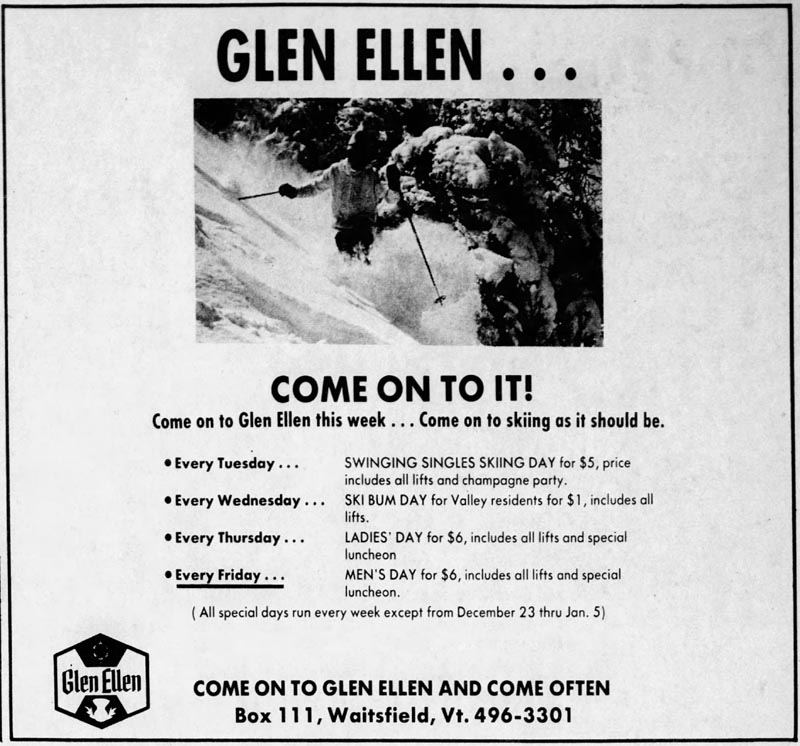
A December 1974 Glen Ellen advertisement |
Despite claims from corporate counsel Andrew Field that "There's no question that Glen Ellen will be able to make it," Brown and Van Loon, Inc. filed for bankruptcy on June 28, 1974 after it was unable to pay its lender, CIT Corporation. Corporate secretary J. Paul Giuliani noted, "If there's no snow you just can't get skiers, and that's it in a nutshell."
Bankruptcy sale advertisements were posted in August, appraising the 1,658-acre ski area at $2.4 million. Unable to find a buyer, CIT Corporation invested $40,000 to get the facilities operational and leased the area to Walt Elliott for the upcoming winter. Two towers and a cable were replaced on the Summit Lift. The area planned on a Thanksgiving opening on manmade snow on the novice slope, but due to warm, rainy weather, it is not known if it actually operated. Skiing on the main mountain likely debuted when a snowstorm hit a week before Christmas, resulting in the best holiday period revenue on record. Washington's Birthday weekend was also a record, including one day that exceeded the previous record by 28%. As skiing came to a close in April, Glen Ellen had reportedly exceeded its previous record season by 20% to 25%.
Harvey Clifford Era
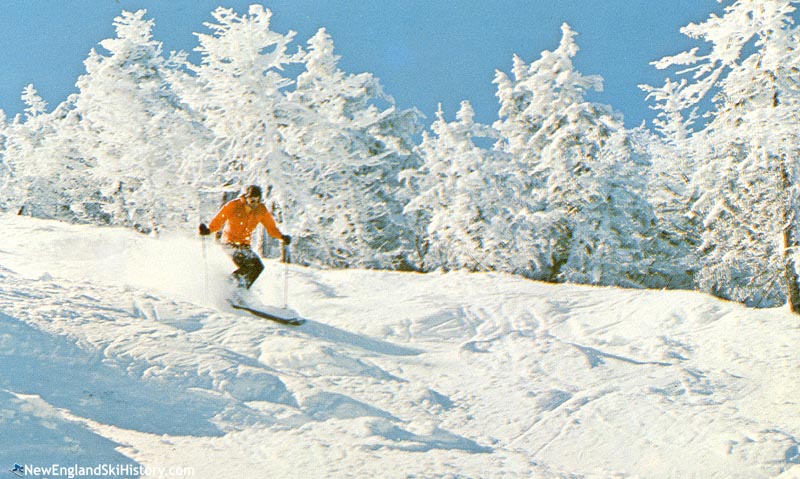
Glen Ellen circa the early 1970s |
In September 1975, Canadian Olympian, former Mount Snow general manager, and outgoing Stratton general manager Harvey Clifford announced an agreement to purchase Glen Ellen from CIT Corporation. Glen Ellen Resorts Ltd. was formed for the acquisition. The purchase price was later reported as $1.38 million.
The 1975-76 season started on manmade snow off the Novice Chair on Thanksgiving Day. The area limped through December with limited snow, unable to open the summit steeps even after a Christmas Day storm. Though Glen Ellen did not plan to host any formal races that season, it did hold the New England Kandahar championship in March when poor conditions forced its relocation from Mad River Glen. A spokesperson said, "We purposefully didn't plan any races this season but we will eventually get into it. We definitely want to do it right, even though this one is a rush job. If the Eastern people need a place and we have the snow available we will really behind them to make it work." The season may have come to a close before the first weekend in April.
Glen Ellen hosted the Vermont Jazz Festival on July 31 and August 1, including prominent musicians Dave Brubeck, Buddy Rich, Maynard Ferguson, George Benson, Chuck Mangione, Gary Burton, Esther Satterfield, Jack DeJohnette, and Bill Evans. Despite rain and mud, the concert drew an estimated 6,000 people per day.
Former ski school director Neil Robinson passed away on October 10, 1976 at the age of 55 following a long illness.
The 1976-77 season once again started on Thanksgiving Day on manmade base off the Novice Chair. With the Rockies having bad year, Vermont areas reported increased business in part due to visitation from the Midwest. Though the area did not much have much of a January thaw, spring came early, resulting in regional flooding and bare spots on the slopes before the middle of March. The season likely melted out at the start of April, but was still reportedly a 25% improvement over the previous winter.
In late April 1977, Harvey Clifford announced plans to construct 300 condominiums, two hotels, and a small village. Clifford also announced plans to install snowmaking on the Inverness slope to sustain business during periods of lean natural snow.
Despite some local resistance, Glen Ellen held the second annual Vermont Jazz Festival on August 6 and 7, 1977. Artists included Roberta Flack, the Pat Metheny Group, Herbie Mann, Chuck Corea, Gary Burton, Rahsaan Roland Kirk, Oregon, Maynard Ferguson, McCoy Tyner, and Stuff (a last-minute substitution for Becker Brothers, which had reportedly disbanded just before the show). With more press than the first year, including a broadcast on National Public Radio, additional precautions were taken, such posting guards around the property to prevent people from sneaking in through the woods. Despite being plagued by rain and mud on the first day, the concert drew estimated crowds of 7,000 each on Saturday and Sunday. It would be the last of its kind, as Fayston Selectmen rejected an application for a 1978 concert, pushing the event to Killington.
The major improvement for the 1977-78 season was the installation of snowmaking on the Inverness slope, giving Glen Ellen the ability to provide manmade snow on more than just the beginner area. More than 5,000 feet of pipe was installed, coupled with the acquisition of 10 Omicrhon Whisper snow guns. The base lodge was also reportedly renovated.
As the season approached, Roy Cohen's Solon Automated Services announced its purchase of Sugarbush, signaling change in the valley. Cohen had been named president of the coin-operated laundry company a few years earlier, with his father Solon remaining as chairman of the board.
The 1977-78 season started at the end of November on limited terrain, but saw natural snow in late December that resulted in the busiest New Year's Eve in area history.
In February 1978, Roy Cohen approached Harvey Clifford about purchasing Glen Ellen. According to Clifford, "it was the furthest thing from my mind." Nevertheless, talks continued.
Enjoying bountiful natural snowfall, the 1977-78 season likely extended to the end of April.
In May 1978, former owner Walt Elliott started a campaign for state representative. On July 10, 1978, Wildcat founder Brooks Dodge ended up in a coma when his Schempp HS-7 glider crashed at a soaring event in Massachusetts. Two days later at the same event, Glen Ellen founder Walt Elliott was killed when his Schempp-Hirth Cirrus glider crashed into a guardrail while attempting to land in Fitchburg. He was 50. Glen Ellen as he knew it would only survive a few months longer.
Glen Ellen Becomes Sugarbush North

Glen Ellen becomes Sugarbush North (September 1978) |
Cohen entered into a purchase and sales agreement for Glen Ellen on August 12, 1978, agreeing to pay $2.4 million. Sugarbush general manager Jack Murphy announced the combined operation would be "the largest ski area east of the Mississippi." When asked about connecting the two areas, Murphy said, "The desire is there, but whether it is physically feasible or not needs some investigation." Glen Ellen owner Harvey Clifford agreed to stay on as consultant.
The $2.4 million deal closed on September 20, 1978, resulting in a 70-trail 13-lift ski area connected by a four-mile shuttle bus route. Glen Ellen was renamed Sugarbush North and was included with Sugarbush passes, while Sugarbush North-only offerings were also made available. Meanwhile, real estate continued to explode in the Mad River Valley, with land going for $1,500 to $3,000 per acre, resulting in the loss of dozens of farms.
Cohen and Solon Automated Services expressed interest in purchasing Okemo a year later, but reportedly did not make a formal offer.
In the fall of 1979, Cohen confirmed that a study had concluded that a trail and lift connection between Sugarbush and Glen Ellen was feasible. Though the United States Forest Service endorsed the plan in 1982, it would not come to fruition. In the end, the two Sugarbush ski areas would only be connected by shuttle service until the installation of the Slide Brook Express chairlift in 1995.
Former owner Roy Cohen passed away on April 9, 2000 at the age of 61.
Expansion History
Image Gallery
Lifts
Click on lift name for information and photos
Maps
Year by Year History
Adult Weekend Full Day Lift Ticket; Adult Full Price Unlimited Season Pass. Window price, including RFID fee and taxes when known.
| 1970s |
Ticket Price |
Season Pass Price |
Pass Payback |
Opening Day |
Closing Day |
Skier Visits |
| 1977-78 | $13.00 |  | $300.00 |  | 23.1 days | November 27 | | |  | | | 1976-77 | $12.00 |  | $275.00 |  | 22.9 days | November 25 | April 3 | |  | | | 1975-76 | $11.00 |  | $250.00 |  | 22.7 days | November 27 | | |  | | | 1974-75 | $11.00 |  | |  | | | April 27 | |  | | | 1973-74 | $10.00 |  | |  | | December 8 | April 14 | |  | | | 1972-73 | $9.00 |  | |  | | December 16 | March 25 | |  | | | 1971-72 | $9.50 |  | |  | | November 25 | | |  | | | 1970-71 | $9.50 |  | $180.00 |  | 18.9 days | November 26 | May 23 | |  | | | 1969-70 | $9.00 |  | $170.00 |  | 18.9 days | November 28 | May 5 | |  | |
| 1960s |
Ticket Price |
Season Pass Price |
Pass Payback |
Opening Day |
Closing Day |
Skier Visits |
| 1968-69 | $9.00 |  | $150.00 |  | 16.7 days | November 16 | May 4 | |  | | | 1967-68 | $8.00 |  | $135.00 |  | 16.9 days | November 23 | April 7 | |  | | | 1966-67 | $8.00 |  | $135.00 |  | 16.9 days | December 3 | April 2 | |  | | | 1965-66 | |  | |  | | November 20 | May 1 | |  | | | 1964-65 | $6.50 |  | $110.00 |  | 16.9 days | December 12 | | |  | | | 1963-64 | $6.50 |  | |  | | December 14 | April 12 | |  | |
Visitor Memories
| "I grew up on the ski school at Glenn Ellen as the assistant director of the ski school in the early 1970s this was a great time and also where I won the Gelunda sprung championships in 1973. What a thrill. I am visiting this area again now 52 years later and to show My Wife the scene of the crimes. lol." | | R. Scott Cameron, Aug. 22, 2025 | | "had great uncrowded runs on not hard trails." | | Noah Meyers, Feb. 22, 2025 | | "I belonged to the Glen Ellen French Ski School at the end of the 60’s. My friend Pierre Stamos, former French National Team member asked me to come to Glen Ellen to help him running the ski school and organize the racing programs.
I arrived before Thanksgiving as I had to race at the Nastar Pacesetter trials in Waterville Valley. I came by bus from Montreal airport to Burlington where Tony Egan the marketing director of the ski area waited for me at the Greyhound depot.
Pierre and I rented a chalet in Moretown north of Waitsfield.
Walt Elliot wanted people to learn the French alpine skiing method following the success of the French Ski Team (Jean-Claude Killy) at the Grenoble Olympics in 1968. The season 1969-1970 was the beginning of the Nastar program at Glen Ellen. I was the qualified pacesetter with a 4 handicap. Then we organized the North American Alpine Championships in March 1970. We had a downhill and a slalom. I remember setting the slalom course and being one of the downhill forerunners. The GS was set on the slope of Mad River because the Inverness lift had a mechanical failure.
All the French ski instructors were from the same area in Haute-Savoie (Morzine, Les Gets an Chamonix).
We had a great time. The weekend atmosphere at the lodge was quite joyful. We had ski movie presentations( Warren Miller)as well as aerobatic skiing (Tom Leroy and Herman Goellner) as well as the famous Harvey Wallbanger sponsored evenings.
I learned about cold and windy climates , skiing on black ice from the top of Mt. Ellen down to the lodge. Even our ultra-sharp edges could not bite into this “concrete ice, so we would ski down between the trees along the lift line grabbing the branches.
Good memories of Walt Elliott and his wife Cynthia." | | Patrick Wahle, May. 27, 2024 | | "I remember skiing GE between 1967-1969 in my high school years. I do not believe I went back after that. We "stumbled" upon GE while visiting MRG and Sugarbush. I recall the long ride up the first double chair and then the steep rise on the summit chair. FIS always looked intimidating and was usually closed until February-March but was a great run when it finally opened. There was no snowmaking or much grooming in those days. I enjoyed the other runs off the top and the cruisers to the right of the lower double. It was long run top to bottom. Good memories of skiing in the 60's. I still love it and chase my grandkids around now." | | Mark Rice, Dec. 23, 2022 | | "I remember learning to ski there as a teenager. The instructor’s spoke French so I don’t remember if they we from France or French Canadian? I just thought it was cool. I still have the little Glen Ellen pins from the ski school that I got over 50 years ago along with some patches. I loved taking my spring break from school and being able to still go up in the mountains and have snow and an occasional spring storm with fresh power- it was wonderful!" | | Debbie Walters, Dec. 21, 2022 | | "My first ski trip was to Glen Ellen in January, 1972. I was 18. It was $22.50 for 5-1/2 days lift ticket (Sunday afternoon through Friday) and it included a group lesson on each weekday (5 lessons). The normal price was $45.00 at the time, but it was half price in January. Stayed at the Snuggery which was a few miles away." | | Bob Kraft, Dec. 3, 2022 | | "I am the daughter of Walton and Cynthia Elliott. I was privileged to have grown up on Mt. Ellen. My home in the 60s was probably the first ski on/ski off home in the states. My parents' vision is legendary. I love hearing the stories. Keep them coming!!!!!" | | tracie elliott, Aug. 28, 2022 | | "We skied Mad River and one day tried Glen Ellen Went to top, got off lift and was terrified Husband expert'- not me! Took me all day to get down!! Don't remember how many kick turns Unfortunately we never went back! This was 1966-67. " | | Bobbye laubenheimer, Feb. 5, 2022 | | "I started on Glen Ellen volunteer Ski Patrol in the early 60's. Every weekend from Thanksgiving to closing was spent patrolling Glen Ellen. Lots of memories. BUT, the most important: the first Saturday in March 1969 there was a line for the main chairlift when I got to the lift so I called for a single (as we were required to do). The person who responded was Robert Sonderman. March 2019 we hope to return to Glen Ellen with family to celebrate 50 years of our meeting and December 9th last year (2017) we celebrated 45 years of marriage. THANK YOU GLEN ELLEN!!!!!!!!!! from Robert and Linda Sonderman " | | Linda Curtis Sonderman, Jan. 1, 2018 | | "I remember skiing at Glen Ellen on opening day in 1963. It was awesome!
I still ski there most of the time." | | Karl Rinker, Dec. 16, 2017 | | "1967 senior ski trip from North Country School (Lake Placid). Loved it, loved it, loved it." | | david gierlach, Dec. 8, 2017 | | "I loved skiing Glen Ellen (as well as Sugarbush)... The GLADES especially... skiing slowly in between the white birch and fir trees laden with new snow... NO noise - just the skis and bindings squeaking... no wind... just snowing softly - but accumulating quickly on the trees and trails... Oh my... what great memories from the early 1970's... Glen Ellen was wonderful...
" | | Dave Lockwood, Aug. 2, 2017 |
|
External Links
Sugarbush Resort - official site
|
Last updated: October 30, 2025
|



